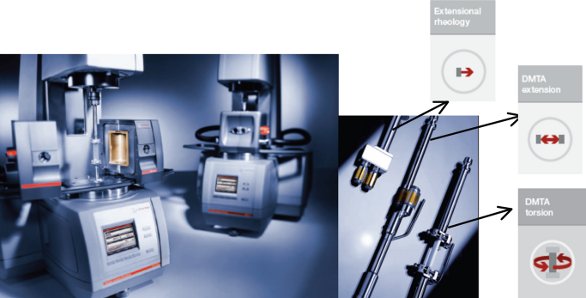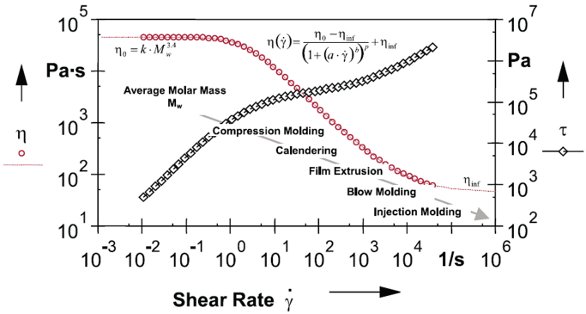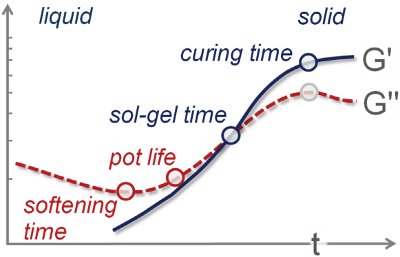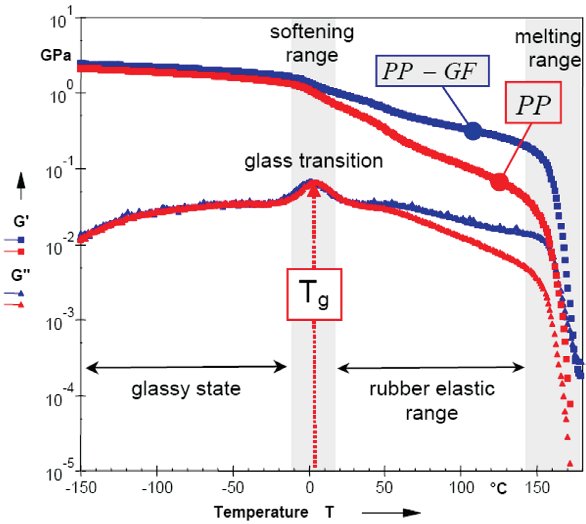Many industries use a rotational rheometer on a daily basis to understand the mechanical properties and flow characteristics of a variety of viscoelastic materials. In the case of thermoset samples such as epoxy resins and adhesives, it is important not only to analyze the material properties prior to curing, but also to analyze the change in mechanical properties during and after the curing process. A modular rotational rheometer offers such flexibility; measurements can be performed either in series or by changing the accessories on the same measurement platform. A modular compact rheometer (MCR) system with a wide array of accessories is described here.
Instrumentation

Figure 1 - Left: MCR xx2 series rotational rheometers (Anton Paar, Ashland, VA) shown with a convection oven accessory with the solid torsion bar fixture. Right: three different measuring systems for the various dynamic mechanical thermal analysis (DMTA) measurement modes used with the MCR xx2.
Rotational rheometers (Figure 1) have different thermal chambers, such as a Peltier plate–hood system (–20 oC to 200 oC); electric plate–hood system (RT to 400 oC); and convection oven (–150 oC to 1000 oC), which enables testing over many temperature ranges and for all stages of samples.
There are also a variety of measuring systems such as parallel–plate and cone–plate, as well as measuring systems for testing solids such as SRF (solid torsion bar fixture for rectangular or circular cross-sections) and UXF (universal extensional fixture) for film and fibers.
Measurement modes
Rotational testing

Figure 2 - Typical flow and viscosity master curve of polymer melt over multiple decades of shear rates.
Shear dependent flow characteristics for the samples can be measured using a plate–plate setup; these curves provide information on the flowability of thermoplastics under different process conditions (see Figure 2). The zero-shear viscosity η0 at low shear rates is an important material property and is directly proportional to the average molar mass, Mw. In order to determine a viscosity curve over a broad range of shear rates, a master curve can be constructed using time temperature superposition in combination with the conversion method, according to Cox-Merz. In addition, conversions from transient tests and a direct measurement with controlled shear rate provide the whole spectrum of shear rates. Powerful regression methods may help to calculate the zero-shear viscosity η0 and the infinite-shear viscosity η∞ in a shear range where all the molecules are totally disentangled and oriented.
Kinetics of reactive materials: Time tests

Figure 3 - Typical DMTA measurement depicting the curing reaction kinetics of a cross-linking sample.
The kinetics of reactive materials is investigated isothermally (Figure 3) or by presetting a temperature ramp and a defined heating rate. The measurement is performed with disposable parallel–plate measuring systems. A special evaluation macro in the application software evaluates the degree of cross-linkage based on the storage modulus and analyzes the sol–gel transition. One of the key features for precisely following reaction kinetics is the fast data acquisition based on accurate and fast strain control. Typical sampling rates of 1 Hz as a quasi-standard or 10 Hz for rapid curing processes can be used. In the case of thermal cross-linkage, the liquid or two-component sample (resin and hardener) is heated and undergoes a viscosity reduction down to the softening point. From this point on, the cross-linkage reaction starts.
Until its pot life the sample is still soft, but subsequently (i.e., at the sol–gel point) transforms into a gel-like state. Then it reaches its curing point and arrives at its final rigidity. Apart from “liquid-to-solid” curing procedures, the instrument also measures the cross-linkage reaction of an epoxy powder or a sample pressed into tablet shape. In a test like this, the sample passes through three phases. At first it is solid and unlinked. After the material’s fusion and melting at the melting point, its cross-linking starts, which leads to the material’s near-complete curing after it passes its curing point.
DMTA in torsion mode

Figure 4 - Typical DMTA measurement for a PP sample compared with PP with glass fibers measured using the solid torsion bar fixture from –150 oC to 200 oC.
Using a DMTA measurement in torsion allows the measurement of the improved mechanical and thermal properties of a polypropylene (PP) sample reinforced with glass fibers in comparison to a pure PP sample, as shown in Figure 4. Due to the low loss factor and the higher modulus values compared to the pure PP sample, the reinforced sample can be mechanically stressed up to 130 °C without considerable deformation taking place. The glass fiber framework gives the sample a certain degree of cohesion, even up into the melting range.
DMTA in extension
The universal extensional fixture enables the measurement of the storage and loss modulus E’ and E’’ as well as the damping factor tan (δ) of thin film sheets and fibers in the glass transition region. The system can be used to characterize multilayer laminates as well as coating films. Typical specimen dimensions (in mm) can be 19 × 5 × 0.05, whereas for extensional melt rheology (in mm) they can be 19 × 10 × 1.
Conclusion
A rotational rheometer along with appropriate accessories can be used as a dynamic mechanical analyzer for DMTA analysis on solids as well as liquids. The modular system performs measurements in torsion and extension and is the first DMTA solution that can also be used for shear rheological experiments with unprecedented precision.
Prajakta Kamerkar, Ph.D. is a Rheologist, Anton Paar USA, 10215 Timber Ridge Dr., Ashland, VA 23005, U.S.A.; tel.: 804-550-1051, ext. 127; fax: 804-412-1901; e-mail: [email protected].